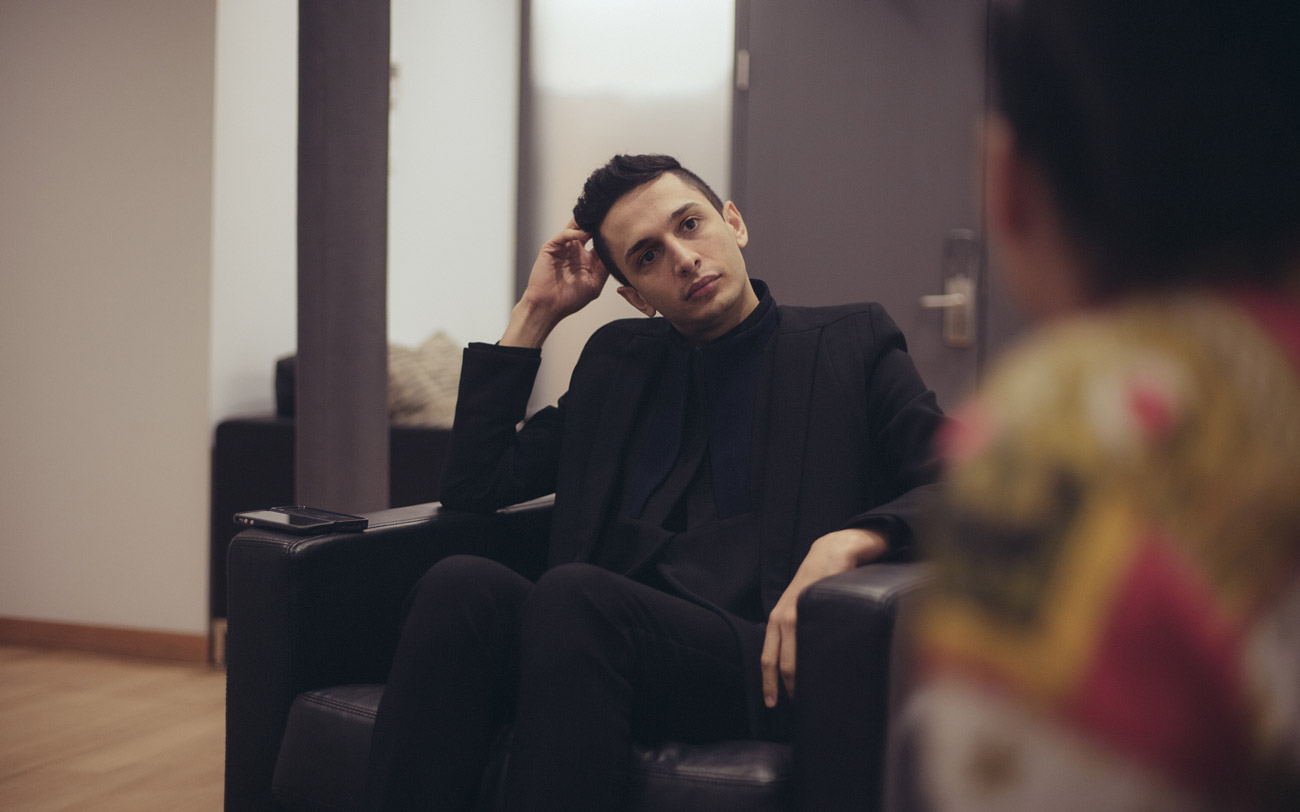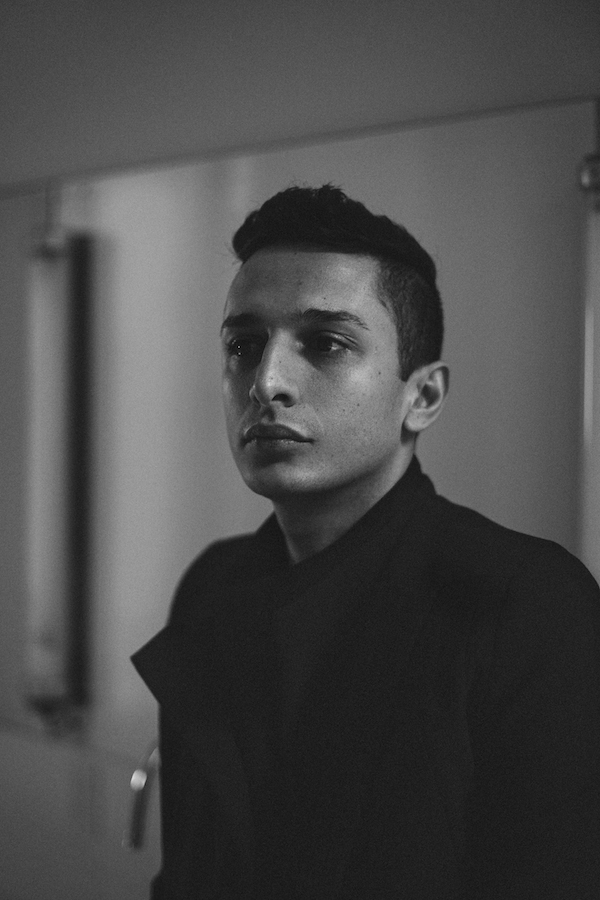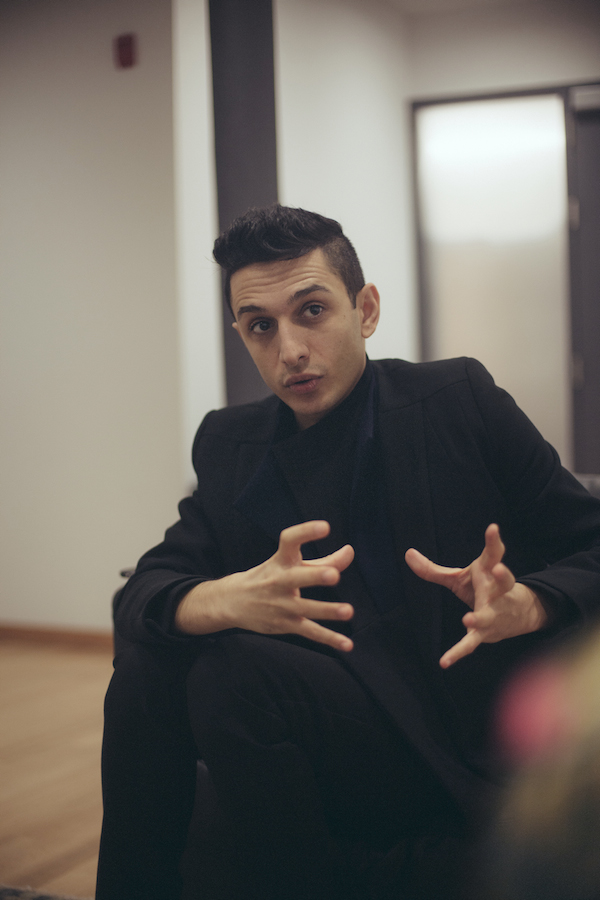
Boundless. adjective \ˈbau̇n(d)-ləs\ : not limited in any way : having no boundaries
When it comes to the retail industry the word “boundless” doesn’t really come to mind. Creating for the timeless, ageless and without confines of sexuality isn’t typically displayed in the window fronts along 5th avenue or on the pages of the most frequented fashion magazines. However it is exactly how one could describe the designs of unisex Haute Couture designer Rad Hourani.
The reality is that the global apparel market was valued at US$1.7 trillion in 2012 and the fashion industry is an industry where models are getting paid an average of $1,500 each per show to walk down a runway during any of the major Fashion Weeks. No wonder it’s hard to break free of the mold. The industry undeniably continues to propel, whether knowingly or unknowingly, the fashion stereotypes of age and gender. Paving your own way is a sink or swim risk and Israeli-born, Montreal native Rad Hourani seems to have jumped into the deep end and has come up floating with the grace of a synchronized swimmer. As he would put it, “Fashion is about trends, sales, about changing every season to incite people to buy, to sell. I’m not interested in that.” The simple notions of industry sales, standards and stereotypes do not apply to this calm demeanour artist, “My clothes can be mixed from my first collection to my last collection very well and you can feel a continuity, you can feel a style, you can feel an identity in it.” Designs, in his view, are not to be sold as “this seasons” must have pieces but furthermore as an extension of each person’s individuality.
In a world where demand and supply has taken precedent, it was great to sit down with a designer who strives to break down the preconceived notions of fashion. Fearless to design in the grey, Rad Hourani has garnered a new style that truly allows for individuals to stand at the forefront of his fashion.

WRG: Does creating a unisex and timeless aesthetic allow for freedom or does it add an element of constraint?
RH: It’s definitely about freedom. It’s a way of being free of any limitations. Unisex does not just define the elimination of gender; it’s also age, race, religion, any boundary that can divide people. The word “unisex” is the base element I took to start my language because I had to create a canvas to fit a man and a woman’s body. I think clothes are some of the first things you express yourself with. When I say unisex, I don’t only mean that you have to be androgynous or gothic; you can be whatever you want to be in a garment that you can adapt to any style you would like to adopt. My designs are to feel ageless, timeless. My clothes have no limits.
WRG: You’re a photographer, an artist, an art designer, a writer all in one. How do you think wearing so many hats fuels your creative process?
RH: I think you cannot express yourself only with clothes. I’ve never been interested in fashion, I’ve never been interested in being a designer or being called a designer. If you see someone, you might judge them by the way they look, but once you know them you hear them talk, you see them move, you see them doing things. I think you cannot express yourself just by the way you are dressed. For me, it’s the same thing. I make a language or a vision and it’s not just about clothes; it’s about a way of being, a way of existing and a way of thinking in the world. I cannot express it just by a garment or a certain picture. Sometimes you need to see someone talking or moving to see what they are about. The same thing for art, the same thing for music. I think all your senses need to be stimulated to really understand something. It’s a canvas that is free from any reference from the past but the shapes are connected to each other.

WRG: You use words like “protection”, “weightless armour” to describe your designs. What does that say about the role you see fashion playing in people’s lives?
RH: I think clothes can transform the way you feel. It’s like at the theater; you wear a gown and you feel like a princess. You wear fishnets and you feel like a whore. Clothes can transform the way you feel, the way you react in society. It just gives you a structure. So I think clothes play a big part of people’s lives.
My question is: who decided a man must dress in a certain way and a woman must dress in a certain way? Who decided a woman should wear heels and a printed flower dress, wear makeup? And men not? I’m not against these things, but where do they come from? I’m interested in it. I’m trying to create something that can adapt itself to any style, full makeup, no makeup, big hair, short hair. It’s important to give people a certain questioning and understanding of how we work and how we are and why. People don’t generally ask themselves why we are how we are. Where do these “it’s okay” and “it’s not” judgments come from? I’m not putting men in heels to provoke, but to try to question why it’s not okay. Maybe a woman wants to feel more masculine. Why do heels suggest femininity?
WRG: You describe your designs as a complete lifestyle. What defines your lifestyle?
RH: My lifestyle… I think I’m a minimalistic person. I like quality over quantity. I like to be with people that can inspire me in terms of the way they think and the way they are. It’s not limitative or anything in the world. Anywhere in the world I feel like home. I don’t have a limitation of nation, of order. I question myself about everything about food, where it comes from. I like to know things about life, where do the things that enter my life come from. I’m not trying to be intellectual, just curious. It’s a lifestyle that can give you the feeling of doing something with your life that can be logical, valuable and contribute to the world in a good way. I just do what feels right to me; some people react to it, some people don’t. I’m happy to see how many people are reacting to it and wearing my clothes in the street and understanding what these clothes are about.
WRG: What along the way is one of the most memorable moments you’ve experienced?
RH: When the president of the Paris Fashion Week called me to confirm that I was a member and I was the first unisex designer in customer history. I was in New York, I was going to FIT to do a speech. That was one of the most memorable moments, but I like to erase everything and start again. I think my most memorable moments will be the things to come. Of course you don’t forget the things that made you who you are today, but I think it’s good to be excited about the future. One time I also worked as a stylist with this lady whose dream was to become a model and her company chose to realize her dream that year. They hired the best of the best in fashion to work on her shoot and I was a stylist at the time so I had to go there to style. She had nothing of a model, nothing at all, not the face, not the shape, but she had dreamed about it since she was a kid like others dream to go to the moon. After the shoot, I received this letter from her and I felt so useful for what I do for once. It’s not about working with the biggest top model in the world. Making her dream come true was one of the most touching moments. Changing someone’s life. That’s amazing.
Boundless. adjective \ˈbau̇n(d)-ləs\ : not limited in any way : having no boundaries
When it comes to the retail industry the word “boundless” doesn’t really come to mind. Creating for the timeless, ageless and without confines of sexuality isn’t typically displayed in the window fronts along 5th avenue or on the pages of the most frequented fashion magazines. However it is exactly how one could describe the designs of unisex Haute Couture designer Rad Hourani.
The reality is that the global apparel market was valued at US$1.7 trillion in 2012 and the fashion industry is an industry where models are getting paid an average of $1,500 each per show to walk down a runway during any of the major Fashion Weeks. No wonder it’s hard to break free of the mold. The industry undeniably continues to propel, whether knowingly or unknowingly, the fashion stereotypes of age and gender. Paving your own way is a sink or swim risk and Israeli-born, Montreal native Rad Hourani seems to have jumped into the deep end and has come up floating with the grace of a synchronized swimmer. As he would put it, “Fashion is about trends, sales, about changing every season to incite people to buy, to sell. I’m not interested in that.” The simple notions of industry sales, standards and stereotypes do not apply to this calm demeanour artist, “My clothes can be mixed from my first collection to my last collection very well and you can feel a continuity, you can feel a style, you can feel an identity in it.” Designs, in his view, are not to be sold as “this seasons” must have pieces but furthermore as an extension of each person’s individuality.
In a world where demand and supply has taken precedent, it was great to sit down with a designer who strives to break down the preconceived notions of fashion. Fearless to design in the grey, Rad Hourani has garnered a new style that truly allows for individuals to stand at the forefront of his fashion.

WRG: Does creating a unisex and timeless aesthetic allow for freedom or does it add an element of constraint?
RH: It’s definitely about freedom. It’s a way of being free of any limitations. Unisex does not just define the elimination of gender; it’s also age, race, religion, any boundary that can divide people. The word “unisex” is the base element I took to start my language because I had to create a canvas to fit a man and a woman’s body. I think clothes are some of the first things you express yourself with. When I say unisex, I don’t only mean that you have to be androgynous or gothic; you can be whatever you want to be in a garment that you can adapt to any style you would like to adopt. My designs are to feel ageless, timeless. My clothes have no limits.
WRG: You’re a photographer, an artist, an art designer, a writer all in one. How do you think wearing so many hats fuels your creative process?
RH: I think you cannot express yourself only with clothes. I’ve never been interested in fashion, I’ve never been interested in being a designer or being called a designer. If you see someone, you might judge them by the way they look, but once you know them you hear them talk, you see them move, you see them doing things. I think you cannot express yourself just by the way you are dressed. For me, it’s the same thing. I make a language or a vision and it’s not just about clothes; it’s about a way of being, a way of existing and a way of thinking in the world. I cannot express it just by a garment or a certain picture. Sometimes you need to see someone talking or moving to see what they are about. The same thing for art, the same thing for music. I think all your senses need to be stimulated to really understand something. It’s a canvas that is free from any reference from the past but the shapes are connected to each other.

WRG: You use words like “protection”, “weightless armour” to describe your designs. What does that say about the role you see fashion playing in people’s lives?
RH: I think clothes can transform the way you feel. It’s like at the theater; you wear a gown and you feel like a princess. You wear fishnets and you feel like a whore. Clothes can transform the way you feel, the way you react in society. It just gives you a structure. So I think clothes play a big part of people’s lives.
My question is: who decided a man must dress in a certain way and a woman must dress in a certain way? Who decided a woman should wear heels and a printed flower dress, wear makeup? And men not? I’m not against these things, but where do they come from? I’m interested in it. I’m trying to create something that can adapt itself to any style, full makeup, no makeup, big hair, short hair. It’s important to give people a certain questioning and understanding of how we work and how we are and why. People don’t generally ask themselves why we are how we are. Where do these “it’s okay” and “it’s not” judgments come from? I’m not putting men in heels to provoke, but to try to question why it’s not okay. Maybe a woman wants to feel more masculine. Why do heels suggest femininity?
“Making her dream come true was one of the most touching moments. Changing someone’s life. That’s amazing.”WRG: You describe your designs as a complete lifestyle. What defines your lifestyle?
RH: My lifestyle… I think I’m a minimalistic person. I like quality over quantity. I like to be with people that can inspire me in terms of the way they think and the way they are. It’s not limitative or anything in the world. Anywhere in the world I feel like home. I don’t have a limitation of nation, of order. I question myself about everything about food, where it comes from. I like to know things about life, where do the things that enter my life come from. I’m not trying to be intellectual, just curious. It’s a lifestyle that can give you the feeling of doing something with your life that can be logical, valuable and contribute to the world in a good way. I just do what feels right to me; some people react to it, some people don’t. I’m happy to see how many people are reacting to it and wearing my clothes in the street and understanding what these clothes are about.
WRG: What along the way is one of the most memorable moments you’ve experienced?
RH: When the president of the Paris Fashion Week called me to confirm that I was a member and I was the first unisex designer in customer history. I was in New York, I was going to FIT to do a speech. That was one of the most memorable moments, but I like to erase everything and start again. I think my most memorable moments will be the things to come. Of course you don’t forget the things that made you who you are today, but I think it’s good to be excited about the future. One time I also worked as a stylist with this lady whose dream was to become a model and her company chose to realize her dream that year. They hired the best of the best in fashion to work on her shoot and I was a stylist at the time so I had to go there to style. She had nothing of a model, nothing at all, not the face, not the shape, but she had dreamed about it since she was a kid like others dream to go to the moon. After the shoot, I received this letter from her and I felt so useful for what I do for once. It’s not about working with the biggest top model in the world. Making her dream come true was one of the most touching moments. Changing someone’s life. That’s amazing.
